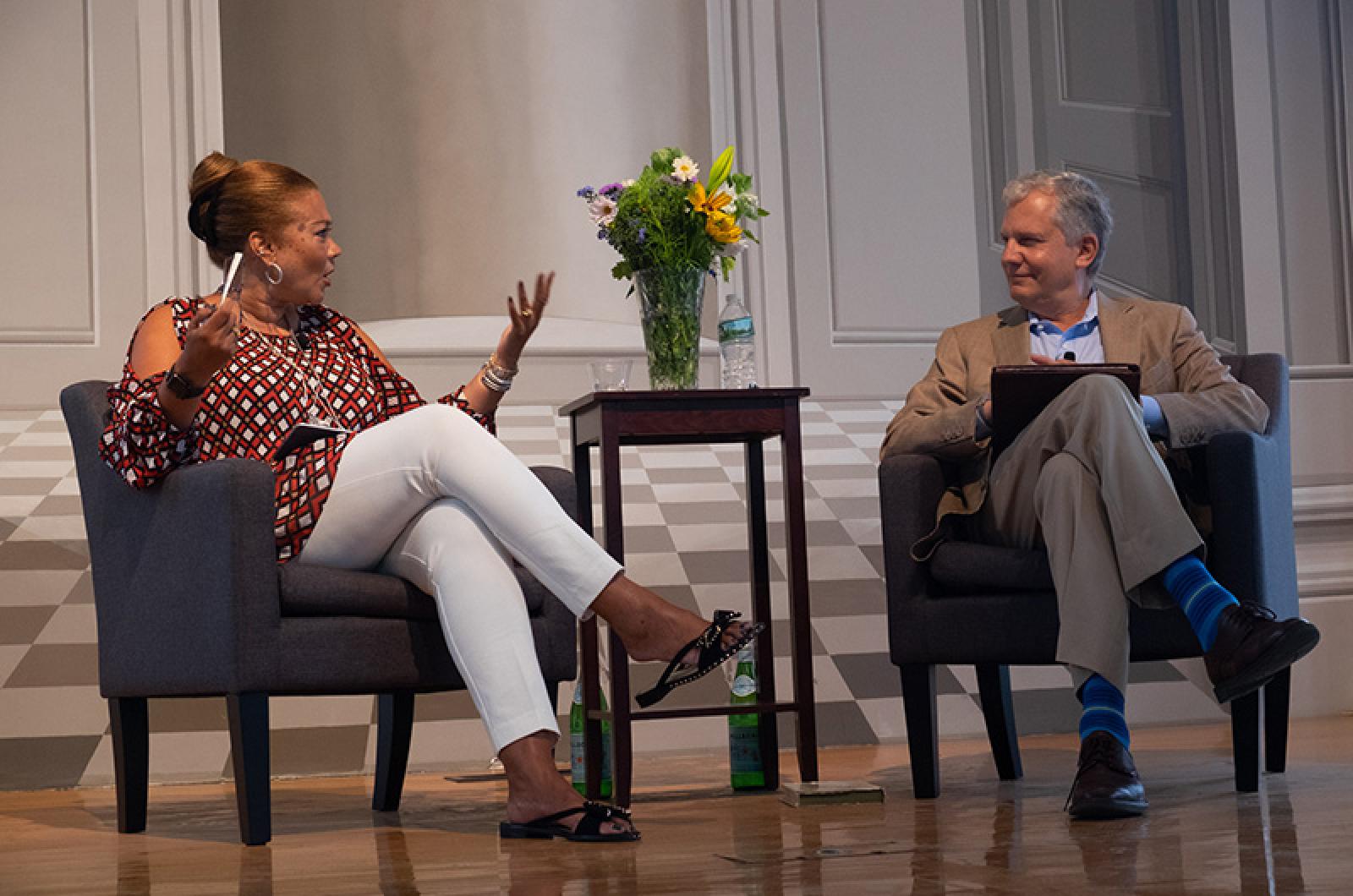The chairman of the board of the New York Times told a sold-out crowd at the Old Whaling Church this week that the future for independent journalism remains bright despite upheaval in the industry and attacks on the credibility of the free press.
“The biggest challenge all of us face is we’re so split as a country,” said Arthur O. Sulzberger Jr. “You just have to have faith that this country will pull itself back together. That’s one of the great strengths of democracy.”
Mr. Sulzberger was interviewed by Peabody Award-winning journalist and former NPR host Michele Norris in a wide-ranging conversation Thursday. The event was sponsored by the Vineyard Gazette.
Relaxed and candid, his remarks punctuated by moments of self deprecating humor, Mr. Sulzberger spoke about his 25 years as publisher of the newspaper during a period of unprecedented change. During his tenure, the newspaper won 53 Pulitzer prizes, and Mr. Sulzberger presided over a transformation of the newspaper’s business model, including the shift from black and white to color printing and ink on paper to digital publishing.
He recently retired as publisher and handed the reins to his son A.G. Sulzberger, who is the fifth generation of his family to lead the Times.
In response to questions from Ms. Norris, he described the state of newspapering in stark terms and told inside stories from the Times.
He described dramatic changes that have occurred on the business side of the paper, where 90 per cent of operating revenues once came from print advertising and 10 per cent from circulation. Today the split is closer to 60-40, with 60 per cent of revenue now coming from subscriptions.
Mr. Sulzberger said the decision to put up an online paywall in 2011 did not come easily and followed a long year of discussion among top executives at the Times.
“There were groups of people that were adamant that a paywall would totally destroy the business,” he said. “In the end it was a very tough decision . . . and we made the call. Thank God we did. Now we have 3.7 million paid subscribers, 2.8 million of which are digital only.”
He said the paper is experiencing international growth, with 15 per cent of subscriptions coming from outside the U.S. and Australia the fastest growing market.
Change was especially hard for the newsroom, Mr. Sulzberger said, citing research that found the culture of newsrooms compares with the military and emergency rooms.
“It’s totally mission driven,” he said describing the constant pressure to get the news out. “The result is you have a culture that’s enormously hard to change . . . because it gets in the way of the mission.”
He described as a pivotal moment the time columnist Thomas Friedman was on an airplane in the 1980s. “The guy next to him said, ‘You’re Tom Friedman, I just read your column.’ Tom replied, ‘That’s funny, how would you have read my column?’”
Mr. Sulzberger paused for effect.
“I read it on the internet,” he said to laughter, adding that he told Mr. Friedman to share the moment with everyone in the newsroom once he returned.
Today growth at the Times has translated to growth in the newsroom where there are some 1,450 employees, Mr. Sulzberger said, a change from 10 years ago when the paper went through a period of buyouts and downsizing.
It’s not the story at most other newspapers, he acknowledged, noting that there are 30,000 people working in newsrooms today compared with 55,000 two decades ago.
Ms. Norris, who currently currently leads an Aspen Institute program on race and inclusion called The Bridge, asked about diversity in the Times newsroom.
The paper’s executive editor Dean Baquet is African-American, but Mr. Sulzberger said the Times has work to do to bring more people of color and women into the newsroom.
“It’s something we put so much effort into. It’s an area of constant focus. My son, to his credit, is even tougher on it than I was,” he said.
The issue surfaced in a different way later during the question and answer period when a member of the audience asked how many people worked in the newsroom who did not have college degrees.
“I suspect there are very few that aren’t college graduates,” he responded. “Quite frankly these days we are going in the opposite direction. We’re going after people with master’s degrees and PhDs.” But he said he took the question as a fair point. “I think the question is do we risk having people covering subjects they aren’t attuned to,” he said, going on to describe efforts to hire people with different backgrounds, skills and political persuasions.
Mr. Sulzberger spoke frankly about the difficult time in 2003 when the paper came into the spotlight over the scandal of Jayson Blair, a reporter that Times editors discovered had been making up stories for years.
Mr. Blair and several other Times editors were let go in the aftermath and Mr. Sulzberger hired a public editor in response.
Ms. Norris prodded Mr. Sulzberger about lessons learned.
“The hardest lesson was not being open to hearing concerns raised by lower-level editors who had broad concerns about Jayson,” he said. “We just weren’t hearing our colleagues.”
In a final question, a member of the audience asked about morale in the Times newsroom in an era where so many people consider the news to be biased and fake.
Mr. Sulzberger responded in emphatic tones that the sense of mission and shared purpose has not wavered, and he urged the audience to subscribe to community newspapers to help keep a free and independent press.
“This is why we’re here . . . to stand up, bring truth to power, to do this without fear or favor, and to stand tall,” he said to applause.







Comments (1)
Comments
Comment policy »